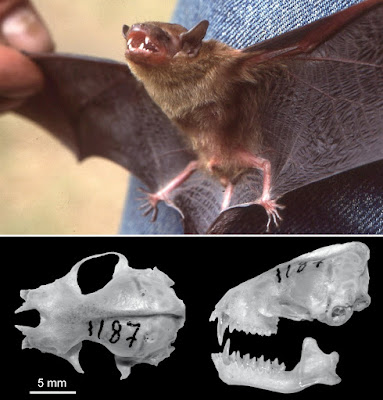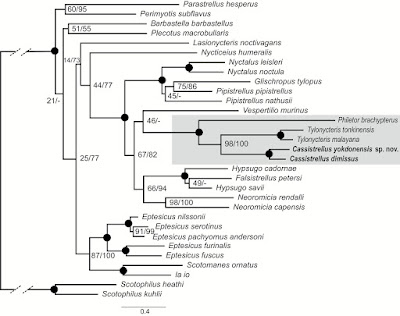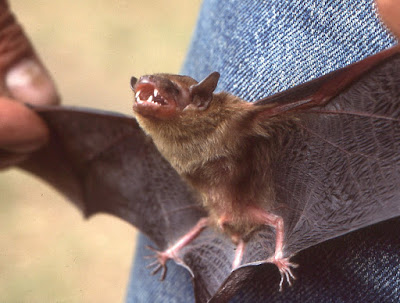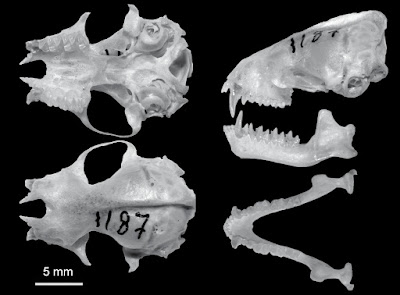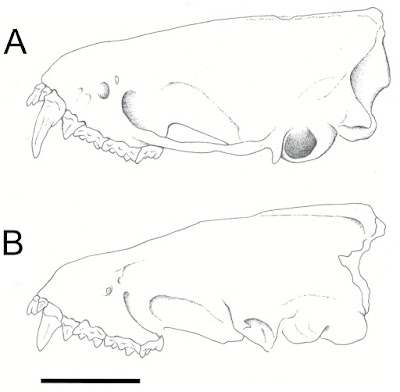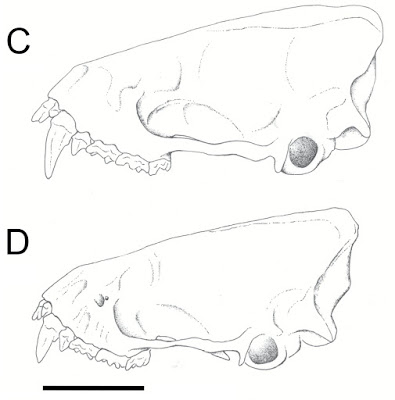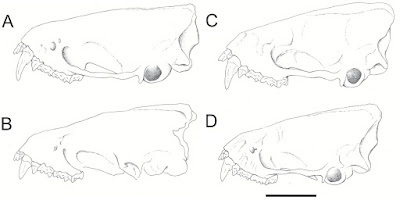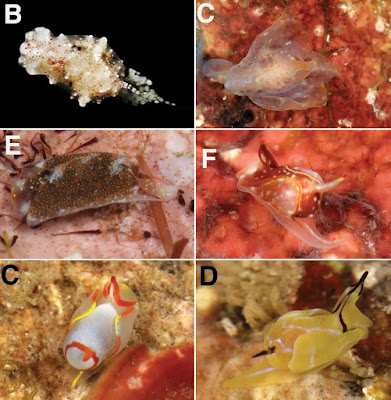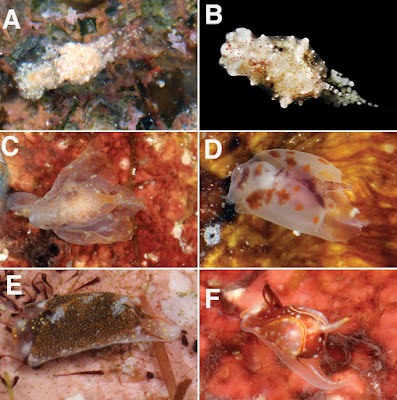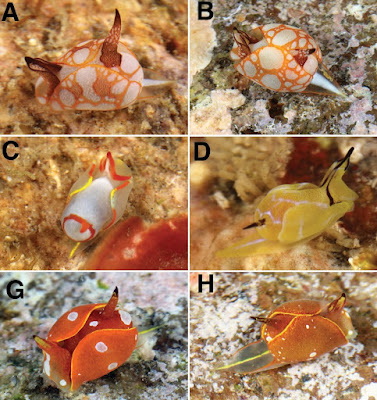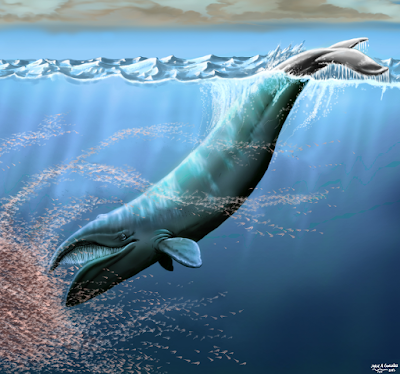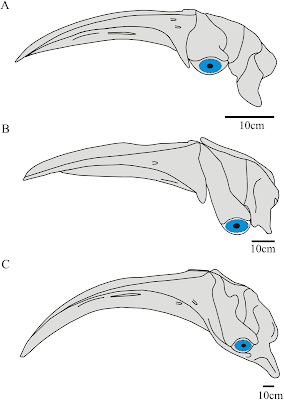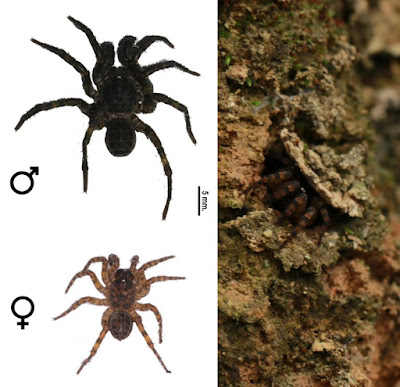[Most Recent Entries] [Calendar View]
Tuesday, December 26th, 2017
| Time | Event | ||||||||
| 9:23a | [Mammalogy • 2018] Cassistrellus gen. nov. • A New Genus and Species of Vespertilionid Bat from the Indomalayan Region: Cassistrellus dimissus & C. yokdonensis
Abstract Bats belonging to the subfamily Vespertilioninae are diverse and cosmopolitan, but their systematic arrangement remains a challenge. Previous molecular surveys suggested new and unexpected relationships of some members compared to more traditional, morphology-based classifications, and revealed the existence of taxonomically undefined lineages. We describe here a new genus and species corresponding to an enigmatic lineage that was previously identified within the genus Eptesicus in the Indomalayan Region. Phylogenetic reconstructions based on mitochondrial and nuclear genes relate the new taxon to Tylonycteris and Philetor, and show that specimens associated with this new genus represent 2 genetically distinct species. Although little is known about their ecology, locations of capture and wing morphology suggest that members of this new genus are tree-dwelling, open-space aerial insect predators. The new species has only been documented from Yok Don National Park in Vietnam, so its conservation status is uncertain until more surveying methods target the bat fauna of the dipterocarp forest in Southeast Asia. Key words: eptesicoid bats, phylogeny, systematics, taxonomy, Vespertilionidae
Cassistrellus gen. nov. Type species: Eptesicus dimissus Thomas, 1916 Description: Species of Cassistrellus are medium-sized vespertilionids (FA 39–47 mm; body mass 12–17 g) characterized externally by short, chestnut-brown pelage that is paler on the ventral parts, by narrow wings with short and pointed tips, and an especially broad muzzle (Fig. 2). Wing membranes are attached to the middle or distal parts of the metatarsus. The tail is mostly included in the uropatagium and extends by 2–3 mm beyond its posterior margin. The calcar extends less than halfway to the tail and may have a small lobe near the ankle. The skull is robust and angular in profile making an almost straight line between the rostrum and the occipital region. It is characterized by well-developed sagittal and lambdoid crests, which meet near the top of the skull to form an occipital helmet. On its ventral surface, the skull has a pair of deep and well-delimited basisphenoid pits located between the cochleae (Fig. 3). Laterally, the lachrymal region has prominent preorbital processes, but the supraoccipital ridges are weak and barely visible. The dental formula is 2113/3123 = 32 teeth, with the upper canines possessing a distinct secondary cusp along the rear edge (Fig. 3). Etymology: The name Cassistrellus derives from the Latin noun “cassis”, which means wearer of a helmet, in reference to the shape of the hind parts of the skull. The suggested English vernacular name is helmeted bat. Geographic distribution: The type specimen of C. dimissus was collected by H. C. Robinson and E. Seimund in Kao Nawng, Bandon (currently within Tai Rom Yen National Park in Surat Thani province of Thailand) at 1,400 feet (= 436 m a.s.l.), in June 1913 (Robinson and Kloss 1915). However, the altitude associated with this specimen was reported by Thomas (1916) as 3,500 feet (= 1,067 m a.s.l.), which would correspond to near the summit of the Khao Nong mountain, where the collectors did not capture bats. As all known localities of Cassistrellus are located in the lowlands at elevation between 190 and 674 m a.s.l., these bats should be indeed regarded as lowland dwellers. The vast area covered by the few scattered records of Cassistrellus suggests that it should be widely distributed from the Isthmus of Kra into mainland Southeast Asia and the foothills of the Himalaya, i.e., across most of the Indo-Burma biodiversity hotspot (Myers et al. 2000a). All capture sites were situated in hilly terrain with mixed deciduous or dipterocarp forests traversed by large rivers.
Cassistrellus yokdonensis sp. nov. Yok Don helmeted bat Eptesicus sp. A JLE-2010: Francis et al., 2010 Holotype: Male ROM 107751 (field number 42734) collected on 6 June 1997 by B. K. Lim and M. Theberge. Preserved as a skin, skull, and partial skeleton. Epiphyses almost completely fused, indicating that this bat was a subadult. Type locality: Vietnam: Dak Lak province; Yok Don National Park, Dak Ken River (tributary of the Serepok River), base of Yok Mt. ..., at 194 m a.s.l. in dry, open dipterocarp forest. Diagnosis: Cassistrellus yokdonensis sp. nov. is a medium-sized vespertilionid bat (body mass about 15 g) characterized by pointed, narrow wings similar in shape to those of Nyctalus species, but not as narrow. The fur is sparse with short hairs, clove brown (Ridgway 1912) dorsally, lighter beige ventrally, and cream colored at the throat. There is no glossy tinge to the fur. The color of the wings and other skin parts is blackish brown. The wing membranes attach to the distal end of the metatarsus. The calcar extends less than halfway to the tail and has no visible lobe. Although the dental formula is identical to that of Eptesicus species, the skull possesses a pair of deep and well-defined basisphenoid pits and prominent preorbital processes that are otherwise absent from the latter genus. C. yokdonensis sp. nov. is morphologically similar to C. dimissus, but—in spite of the fact that the known individuals are not fully grown adults—is substantially larger, both externally (e.g., FA 47 mm versus 39–42 mm; Table 1), and cranially (e.g., maxillary toothrow length over 6.5 mm versus less than 6.4 mm). C. yokdonensis sp. nov. has also a much stronger dentition in general, and subequal small lower premolars, longer more curved upper canines, and procumbent upper incisors compared to its congener. Genetically, C. yokdonensis sp. nov. has unique mitochondrial (Cytb, Co1) and nuclear (Rag2) sequences compared to C. dimissus from Laos. Etymology: We propose the name C. yokdonensis after the national park where it has been found, in recognition of the importance of protected areas in conserving species and their habitats. Geographic distribution: Currently known only from Yok Don National Park, Dak Lak Province of Vietnam. The 2 specimens were caught shortly after 2100 h as they flew into large (30 m long by 10 m high) canopy nets deployed in a dry, open dipterocarp forest of lowland regions. Other species of mammals caught in the same nets included Taphozous, Pipistrellus, Murina, Cynopterus, Megaerops, and Rhinolophus bats and several Hylopetes flying squirrels. In addition, a paratype specimen of a new species of parachute gecko (Ptychozoon trinitaterra) was caught in this net (Brown 1999). Manuel Ruedi, Judith L. Eger, Burton K. Lim and Gábor Csorba. 2017. A New Genus and Species of Vespertilionid Bat from the Indomalayan Region. Journal of Mammalogy. gyx156. DOI: 10.1093/jmammal/gyx156 | ||||||||
| 9:34a | [Mollusca • 2017] Like A Bat Out of Heaven: the Phylogeny and Diversity of the Bat-winged Slugs (Heterobranchia: Gastropteridae) Abstract A molecular phylogeny is presented for 25 newly sequenced specimens of Gastropteridae. The present phylogeny was estimated by analysing the nuclear fragment 28S and two mitochondrial fragments cytochrome c oxidase I (COI) and 16S using maximum likelihood and Bayesian analyses. The distinctness of eight new species of Gastropteridae is supported by the molecular phylogeny and by subsequent Automatic Barcode Gap Discovery (ABGD) analysis. Morphological data also support the distinctness of these species. The following species are described here: Gastropteron minutum Ong and Gosliner sp. nov., Gastropteron multo Ong and Gosliner sp. nov., Sagaminopteron multimaculatum Ong and Gosliner sp. nov., Siphopteron vermiculum Ong and Gosliner sp. nov., Siphopteron flavolineatum Ong and Gosliner sp. nov., Siphopteron nakakatuwa Ong and Gosliner sp. nov., Siphopteron makisig Ong and Gosliner sp. nov. and Siphopteron dumbo Ong and Gosliner sp. nov. All of these species, spanning much of the phylogenetic tree of Gastropteridae, are found in a single, highly diverse region of the Philippines, the Verde Island Passage. These data support the hypothesis that this region is an area of high species richness as well as phyletic diversity. This study also supports strong correlation between morphological characters and the molecular phylogeny within the species of Siphopteron. Molecular studies also indicate the distinctness of specimens of Siphopteron quadrispinosum from Hawaii and those from the western Pacific. Western Pacific specimens should be regarded as Siphopteron leah. Siphopteron pohnpei is transferred to Sagaminopteron based on the molecular phylogeny. Other species complexes indicating the presence of geographically separated cryptic species indicate that further detailed study of this group is warranted and that hidden diversity is likely to increase with additional study. Based on our morphological studies and molecular phylogeny, we confirmed that the eight new species hypothesized from our field observations of living animals all represent new species that are described here. Our molecular phylogeny also indicates the likely existence of geographically isolated cryptic species within previously classified specimens. Sagaminopteron psychedelicum from Madagascar appears to represent a cryptic species distinct from western Pacific populations, as is Sagaminopteron nigropunctatum from Saudi Arabia. Also, the western Indian Ocean specimen of S. tigrinum represents a cryptic species distinct from the western Pacific S. tigrinum. The lack of strong support for the monophyly of Gastropteron and Siphopteron requires additional study of taxa to determine whether greater support of these lineages is found when taxon sampling is increased. Also the phylogenetic and systematic relationship of Enotepteron needs to be examined when members of this taxon become available for molecular studies. Elise Ong, Joshua M Hallas and Terrence M Gosliner. 2017. Like A Bat Out of Heaven: the Phylogeny and Diversity of the Bat-winged Slugs (Heterobranchia: Gastropteridae). Zoological Journal of the Linnean Society. 180(4); 755–789. DOI: 10.1093/zoolinnean/zlw018 | ||||||||
| 9:55a | [PaleoMammalogy • 2017] The early Miocene Balaenid Morenocetus parvus from Patagonia (Argentina) and the Evolution of Right Whales
Abstract Balaenidae (right and bowhead whales) are a key group in understanding baleen whale evolution, because they are the oldest surviving lineage of crown Mysticeti, with a fossil record that dates back ∼20 million years. However, this record is mostly Pliocene and younger, with most of the Miocene history of the clade remaining practically unknown. The earliest recognized balaenid is the early Miocene Morenocetus parvus Cabrera, 1926 from Argentina. M. parvus was originally briefly described from two incomplete crania, a mandible and some cervical vertebrae collected from the lower Miocene Gaiman Formation of Patagonia. Since then it has not been revised, thus remaining a frequently cited yet enigmatic fossil cetacean with great potential for shedding light on the early history of crown Mysticeti. Here we provide a detailed morphological description of this taxon and revisit its phylogenetic position. The phylogenetic analysis recovered the middle Miocene Peripolocetus as the earliest diverging balaenid, and Morenocetus as the sister taxon of all other balaenids. The analysis of cranial and periotic morphology of Morenocetus suggest that some of the specialized morphological traits of modern balaenids were acquired by the early Miocene and have remained essentially unchanged up to the present. Throughout balaenid evolution, morphological changes in skull arching and ventral displacement of the orbits appear to be coupled and functionally linked to mitigating a reduction of the field of vision. The body length of Morenocetus and other extinct balaenids was estimated and the evolution of body size in Balaenidae was reconstructed. Optimization of body length on our phylogeny of Balaenidae suggests that the primitive condition was a relatively small body length represented by Morenocetus, and that gigantism has been acquired independently at least twice (in Balaena mysticetus and Eubalaena spp.), with the earliest occurrence of this trait in the late Miocene–early Pliocene as represented by Eubalaena shinshuensis. Systematic palaeontology Cetacea Brisson, 1762 Neoceti Fordyce & Muizon, 2001 Mysticeti Gray, 1864 sensu Cope, 1869 Chaeomysticeti Mitchell, 1989 Balaenidae Gray, 1825 Morenocetus Cabrera, 1926 Type species by monotypy: Morenocetus parvus Cabrera, 1926. .... Mónica R. Buono, Marta S. Fernández, Mario A. Cozzuol, José I. Cuitiño and Erich M.G. Fitzgerald. 2017. The early Miocene Balaenid Morenocetus parvus from Patagonia (Argentina) and the Evolution of Right Whales. PeerJ. 5:e4148. DOI: 10.7717/peerj.4148 | ||||||||
| 10:59a | [Arachnida • 2017] Liphistius maewongensis • A New Liphistius Species (Mesothelae: Liphistiidae: Liphistiinae) from Thailand, with Notes on its Natural History
Abstract A new species of trapdoor spider of the genus Liphistius Schiödte, 1849 (Mesothelae: Liphistiidae) is described from specimens collected from Mae Wong National Park, Klonglan district, Kamphaeng Phet province, Thailand. This Liphistius species belongs to the bristowei species-group based on the elevated cumulus and the distinct embolic part, and resembles L. yamasakii Ono, 1988. Diagnostic characters of the male and female are discussed, and a map is provided for the type localities of the 32 previously described Liphistius species in Thailand. This is the first record of a Liphistius species in the bristowei species-group that builds a T- or Y-shaped burrow with two trapdoor openings. Keywords: Systematics, checklist, conservation, spider Family Liphistiidae Thorell, 1869 Subfamily Liphistiinae Thorell, 1869 Genus Liphistius Schio¨dte, 1849 Liphistius maewongensis sp. nov Etymology.— The specific epithet refers to the type locality, Mae Wong National Park, an important tiger sanctuary in Southeast Asia. Remarks.— Liphistius maewongensis belongs to the bristowei species-group sensu Schwendinger (1990), based on the elevated cumulus (Figs. 4a–d) and the two longitudinal ridges on the sclerotized part of the embolic parts that reach the tip (Fig. 4e). Thus, the bristowei species-group of Liphistius is currently comprised of L. bristowei, L. lannaianus, L. marginatusSchwendinger, 1990, L. yamasakii, and L. maewongensis. Despite the similarity between L. yamasakii and L. maewongensis, the male pedipalp shapes are grossly different. Varat Sivayyapram, Deborah Roan Smith, Suthon Weingdow and Natapot Warrit. 2017. A New Liphistius Species (Mesothelae: Liphistiidae: Liphistiinae) from Thailand, with Notes on its Natural History. Journal of Arachnology. 45(3); 287-295. DOI: 10.1636/JoA-S-17-028.1 biodconference.org/wp-content/uploads/20 พบ ‘แมงมุมฝาปิดโบราณ’ ชนิดใหม่ของโลกที่แม่วงก์ seub.or.th/index.php?option=com_content&v |
| << Previous Day |
2017/12/26 [Calendar] |
Next Day >> |
